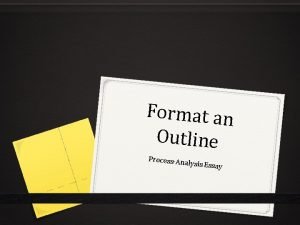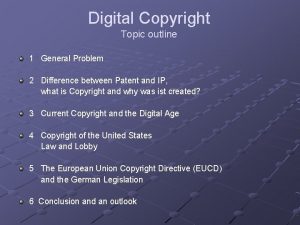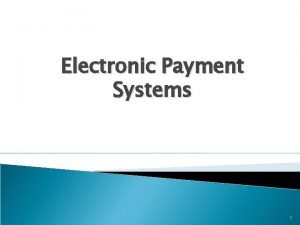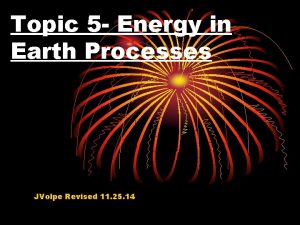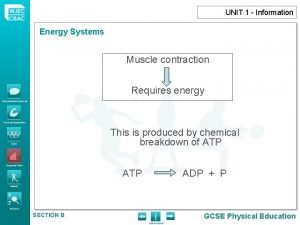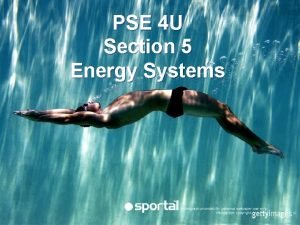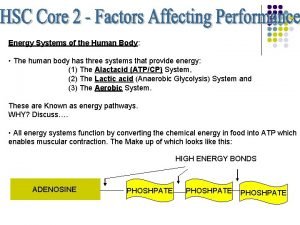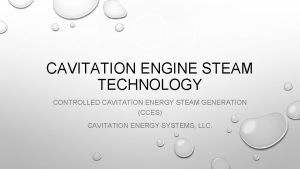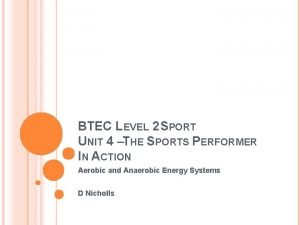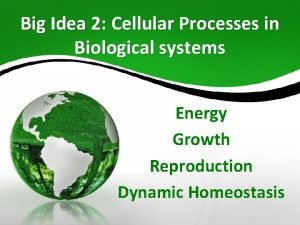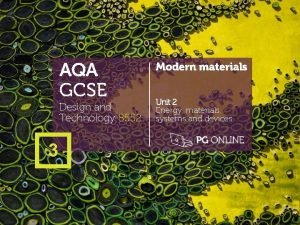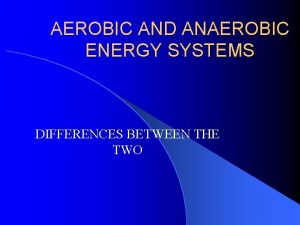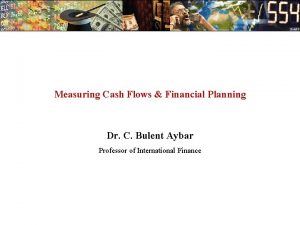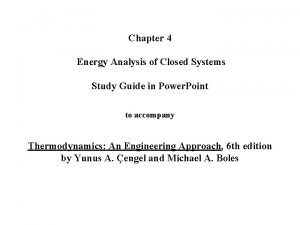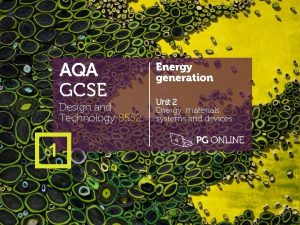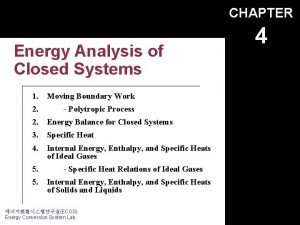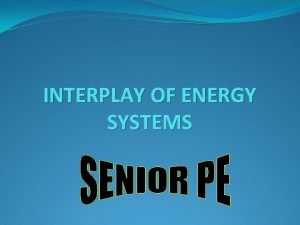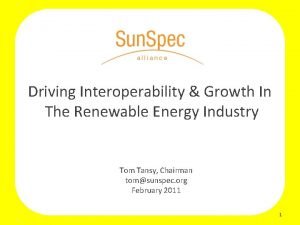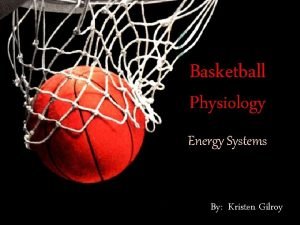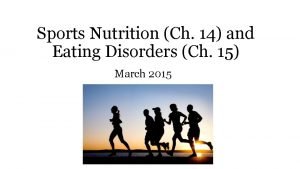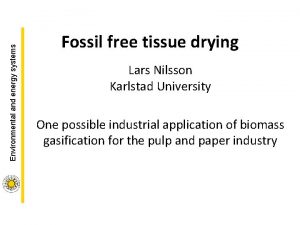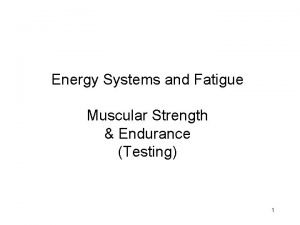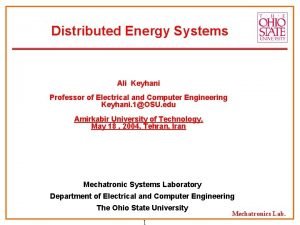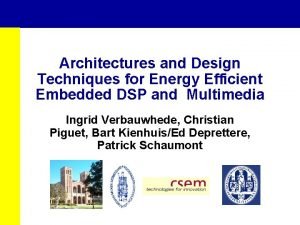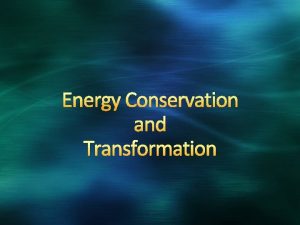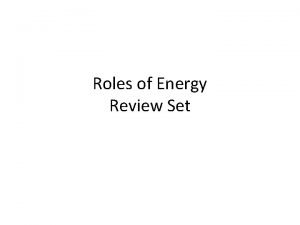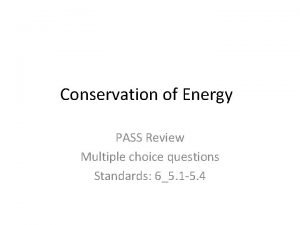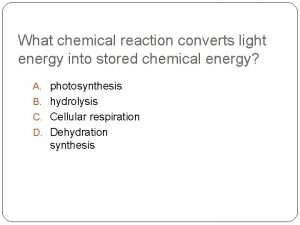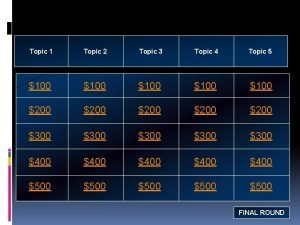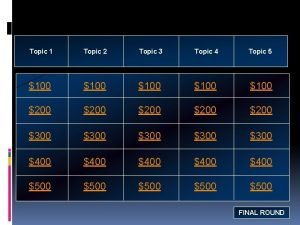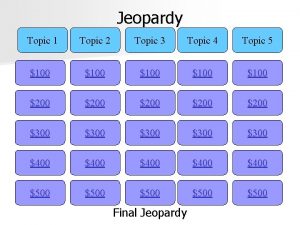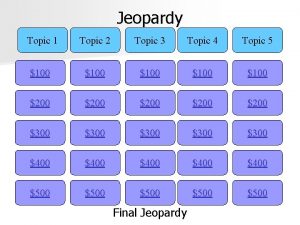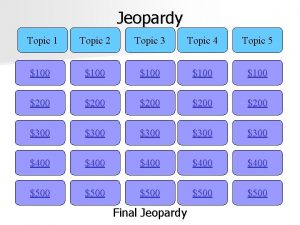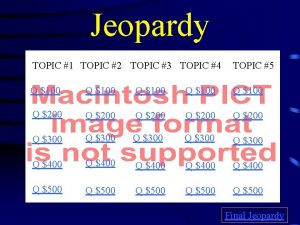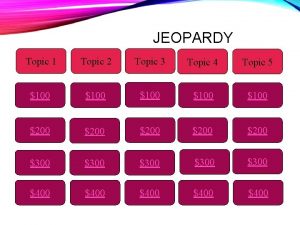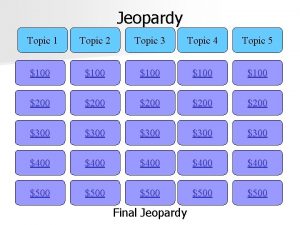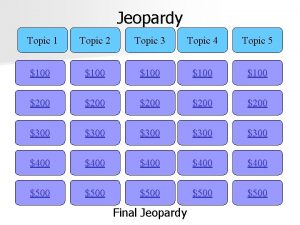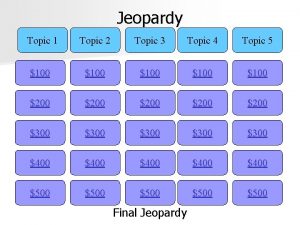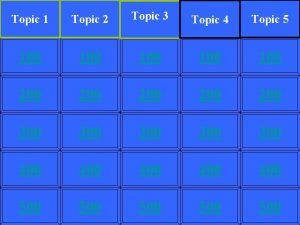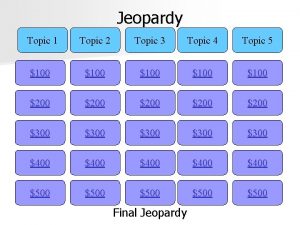TOPIC 3 Energy systems 3 2 1 Outline


































































- Slides: 66

TOPIC 3 Energy systems

3. 2. 1 Outline the terms metabolism, anabolism, aerobic catabolism and anaerobic catabolism. Metabolism is the set of chemical reactions that occur in living organisms in order to maintain life. These processes allow organisms to grow and reproduce, maintain their structures, and respond to their environments. Metabolism is usually divided into two categories. Catabolism breaks down organic matter, for example to harvest energy in cellular respiration. Anabolism, on the other hand, uses energy to construct components of cells such as proteins and nucleic acids.

Anabolism & Catabolism Anabolism is the building up of things – a succession of chemical reactions that constructs or synthesizes molecules from smaller components, usually requiring energy in the process. Catabolism is the breaking down of things – a series of destructive chemical reactions that break down complex molecules into smaller units, and in most cases releasing energy in the process.

Anabolism Making bigger things out of smaller things and using up energy in the process. Allows the body to grow new cells and maintain all the tissues. The body uses simple molecules to create complex ones. The same way a builder will use simple building blocks, such as bricks, to create a house. Examples: the growth and mineralization of bone and increases in muscle mass.

Anabolism The anabolic process uses monomers to build polymers. A polymer is a large complex molecule made of many small molecules that are similar to each other. Those small molecules are called monomers. Example: amino acids, which are simple molecules (monomers)… through a series of anabolic chemical reactions build… proteins, which are large and complex molecules (polymers).

Catabolism Catabolism breaks things down and gives out energy. Using bigger things to make smaller things and releasing energy in the process. Catabolism provides the energy our bodies need for physical activity, from a cellular level right up to whole body movements. When we eat our body breaks down the organic nutrients – this breaking down process releases energy, which is stored inside molecules of adenosine triphosphate (ATP) in the body. (more to come on this).

Catabolism The catabolic chemical reaction in the living cell break down polymers into their constituent monomers. Example: Polysaccharides are broken down into monosaccharides. Complex carbs are broken down into simple carbs. Example: Proteins are broken down into amino acids. Example: lipids are broken down into fatty acids.

How they work together… The energy stored in ATP is the fuel for anabolic reactions. Catabolism creates the energy that anabolism consumes for synthesizing hormones, enzymes, sugars and other substances for cell growth, reproduction, and tissue repair. If catabolism is producing more energy than anabolism requires there will be excess energy. The human body stores this excess energy in fat or glycogen.

Metabolism diagram On white board…

Carbohydrate Metabolism Read the section on carbohydrate metabolism in your textbook (pages 63 -64). Use the information to fill in the blanks in your workbook.

3. 2. 2 State what glycogen is and its major storage sites. Glycogen is a polysaccharide of glucose. It is the storage form of glucose in animals and humans. Glucose can be used immediately for metabolism to make energy. The glucose that is not used immediately is converted in the liver and muscles into glycogen for storage by the process of glycogenesis. Glycogen forms an energy reserve that can be quickly mobilized to meet a sudden need for glucose, but one that is less compact than the energy reserves of triglycerides (fat).

Fat Metabolism The energy yielding process in fat metabolism is the ẞ-oxidation of fatty acids. This process occurs in the mitochondria. Fatty acids are broken down to acetyl Co. A molecules by shortening the fatty acid chain 2 carbons at a time. More energy is released when acetyl Co. A is further metabolised in the Kreb’s Cycle

3. 2. 3 State the major sites of triglyceride storage. Eating more fat than the body requires leads to excess fat being stored as triglycerides in both addipose (fat) tissue, and skeletal muscles. Lipolysis is the process of releasing stored fat from the body’s reserves so it can be used as energy when needed.

Nutrition Projects!

3. 2. 4 Explain the role of insulin in the formation of glycogen and the accumulation of body fat. Insulin is produced in the pancreas to help lower your blood sugar level. Beta cells make insulin. Kidney: when blood glucose is present in normal amounts, kidneys make sure no glucose is lost in the urine. Tell tale sign you’re diabetic… your urine has lots of sugar in it.

How does insulin work… After you have eaten a meal the glucose concentration in the blood rises. This signals the pancreas to secrete insulin. Insulin increases the transport of glucose into the cell, especially the skeletal muscle cells and liver cells. Excess glucose will be stored as fat. Fast uptake of glucose in the blood stops the release of glucose from the liver and muscle stores and promotes the synthesis of glycogen in the liver and muscle.

Explanation – on white board

How does insulin work continued… Insulin stimulates glycolysis – to signal energy availability to all organs Insulin inhibits gluconeogenesis – the conversion of protein or fat into glucose Insulin promotes glycogenesis – the conversion of glucose to glycogen Insulin inhibits lipolysis in fat stores and the breakdown of proteins. Insulin promotes the synthesis of proteins Insulin promotes the storage of triglycerides in adipose tissue

After Fasting When blood glucose decreases (as it does after fasting or exercise which burns energy) the hormone glucagon is secreted. Glucogon acts in opposition to insulin, stimulating glycolysis and the synthesis of glucose. Glucagon also activates lipolysis of triglycerides which adds to the energy supply.

Insulin and Fat Accumulation Receptors in the pancreas are sensitive to the changes in sugar level, thus releasing the necessary requirements of insulin and glucagon depending on the needs of the body. A diet high in sugar and fat will result in a high release of insulin and consequently an increase in glycogen storage and accumulation of fat.


3. 2. 5 Outline the terms glycogenolysis and lipolysis. Glycogenolysis is the formation of blood glucose by hydrolysis of stored liver glycogen. In other words, it is the breakdown of glycogen to glucose. In the liver, the breakdown of glycogen results in elevated blood glucose. In the muscle, the breakdown of glycogen is used by the muscle for energy. There is no release of glucose into the blood stream from the muscle. This occurs as a result of the hormone

Lipolysis is the breakdown of triglycerides stored in adipose tissue. Triglycerides undergo lipolysis and are broken down into glycerol and fatty acids. During this process, free fatty acids are released into the bloodstream and circulate throughout the body. The following hormones induce lipolysis: epinephrine (also called adrenaline), norepinephrine, glucagon

3. 2. 6 Outline the functions of glucagon and adrenaline during fasting and exercise. During fasting and exercise the blood glucose level drops and therefore the release of glucagon and adrenaline will result in an increase of blood glucose. In the liver, the breakdown of glycogen results in elevated blood glucose (glycogenolysis) by glucagon and adrenaline (epinephrine) Epinephrine (adrenaline) stimulates the breakdown of muscle cell glycogen into glucose. This glucose is not released into the blood but rather becomes a supportive energy source for the muscle cells while fat is the major energy source. Lipolysis breaks down triglycerides to be used as energy. Epinephrine (adrenaline) is one of the hormones which induces lipolysis.


3. 2. 7 Explain the role of insulin and muscle contraction on glucose uptake during exercise. Insulin will result in an increased uptake of blood glucose into the liver and muscle. Muscle contraction will also result in an increase of blood glucose uptake from the blood due to higher energy demands. See earlier diagram that was copied from the white board (Glut-4 diagram).

3. 3. 1 Draw a diagram to show the ultrastructure of a generalized animal cell. With ribosomes Apparatu s

Nucleus: A membrane enclosed organelle found in cells. It contains chromosomes made up of DNA and protein. The DNA component of the chromosomes forms the genes which direct what proteins the cell will make.

Ribosomes: responsible for the manufacture of proteins. They are often found in the endoplasmic reticulum but can also be found in other areas of the cell. Endoplasmic reticulum: (literally translated: ‘network within the cytoplasm). A network of membrane-bound channels providing a means of transport within the cells. � Rough endoplasmic reticulum: is coated with ribosomes. � Smooth endoplasmic reticulum: generally found in cells producing lipids (fat), is devoid of ribosomes. )

Golgi apparatus: a series of flattened membranous sacs which are believed to store materials prior to secretion from the cell. This is achieved by small vesicles which break off from the golgi apparatus and fuse with the cell membrane. Lysosome: a membrane bound structure found in animal cells which contain very powerful digestive enzymes.

Mitochondrion: a membrane bound structure consisting of a series of folded membranes. On these membranes, the reactions of aerobic respiration occur which produces energy for use by the cell.

3. 3. 2 Draw a diagram to show the ultrastructure of a mitochondrion.

Mitochondria are membrane-enclosed organelles distributed through the cytosol of cells. Their number within the cell ranges from a few hundred to, in very active cells, thousands. Their main function is the conversion of the potential energy of food molecules into ATP. Mitochondria have: an outer membrane that encloses the entire structure an inner membrane that encloses a fluid-filled matrix between the two is the intermembrane space the inner membrane, cristae, is elaborately folded projecting into the matrix. The number of mitochondria in a cell can � � increase by mitosis (after aerobic training) decrease by their fusing together. (after a period of inactivity)

3. 3. 3 Define the term cell respiration. Carbohydrates, fats, and proteins can all be broken down and used as energy in cellular respiration. Cell respiration is the set of metabolic reactions and processes that take place in the cells of organisms to convert energy from nutrients into adenosine triphosphate (ATP), and then release waste products. The reactions involved in respiration are catabolic reactions, which break large molecules into smaller ones and releasing energy in the process.

ATP provides energy necessary for body functions (adenosine triphosphate) Breakdown of Energy currency Biochemical processes Carbohydrates Muscular work Fats Thermoregulation Proteins Digesting food ATP

We can divide cellular respiration into three metabolic processes: glycolysis, the Krebs cycle, and oxidative phosphorylation. Each of these occurs in a specific region of the cell. 1. Glycolysis occurs in the cytosol (intracellular fluid – liquid found inside cells). 2. The Krebs cycle takes place in the matrix of the mitochondria. 3. Oxidative phosphorylation via the electron transport chain is carried out on the inner mitochondrial membrane.


3. 3. 4 Explain how adenosine can gain and lose a phosphate molecule. ATP, adenosine triphosphate, is an energy rich chemical compound which serves as the immediate source of energy of most of the reactions in the body, especially muscle contraction. It is often referred to as the energy currency of life. ATP is made up of a smaller compound (adenosine) and three phosphate groups (hence the name triphosphate).

ATP works by losing the endmost phosphate group when instructed to do so by an enzyme. This reaction releases a lot of energy, which can then use to build proteins, contract muscles, etc. The end product is adenosine diphosphate (ADP), and the phosphate molecule.

When the body is resting and energy is not immediately needed, the reverse reaction takes place and the phosphate group is reattached to the molecule using energy obtained from food. This is called phosphorylation. Thus the ATP molecule acts as a chemical 'battery', storing energy when it is not needed, but able to release it instantly when the body requires it.

3. 3. 5 Explain the role of ATP in muscle contraction. All muscle fibres have the capacity to produce ATP using carbs and fats. The release of energy from the breakdown of ATP to ADP provides energy for muscle contraction. There is enough ATP in muscles for 2 seconds of muscle activity. Any activity lasting longer than 2 seconds must use ATP generated from energy systems.

The main function of energy systems is to produce ATP. In muscle fibres the performance of the energy systems influences the contractions of the muscle This in turn influences our ability to perform different types of exercise.

Three Energy Systems 1. Phosphagen system (anaerobic – without Oxygen) 2. Lactic Acid system (anaerobic – without oxygen) 3. Aerobic system (aerobic – with oxygen)

The Roles of the Three Energy Systems in Competitive Sport

3 Energy Systems continued…

There is overlap with the systems.


Phosphagen (ATP-CP) System The phosphagen system provides ATP immediately to the muscle, so the energy needs of fast and powerful movements are met in the immediate area of the muscle’s contractile machinery. Creatine phosphate (a high energy molecule) is broken down by creatine kinase to provide energy for the re-synthesis of ATP that has been utilized during the initial stages of exercise. Creatine kinase breaks down CP by removing the phosphate group and transfers it to ADP to form

3. 3. 6 Describe the re-synthesis of ATP by the ATP–PC system. P phosphate Fuel source PC + Creatine Enzyme: creatine kinase breaks down PC


Phosphogen (ATP-CP) System Overview Primary fuel source: Stored ATP, CP (creatine phosphate) Duration of activity: 10 seconds Sporting events: Weight lifting, high jump, long jump, 100 m run, 25 m swim Advantages: Produces very large amount of energy in a short amount of time. High intensity power for explosive activities. Fast acting because it doesn’t require oxygen (anaerobic). No harmful by-products like lactic acid. Disadvantages: Initial concentration of high energy phosphates (ATP, CP). Short duration. Inefficient energy yield is low 1: 1(1 PC for every 1 ATP).

Lactic Acid System Anaerobic – without oxygen Also known as anaerobic glycolysis The breakdown of glucose to pyruvate without the use of oxygen. Pyruvate is then converted into lactic acid, which limits the amount of ATP produced (2 ATP molecules). Lactic acid accumulates within the muscle and reduces the p. H because it is a strong acid. This causes discomfort but also reduces the ability of muscle to contract and we begin to slow down. This system is generally used for high to medium

3. 3. 7 Describe the production of ATP by the lactic acid system. Draw diagram on board

Lactic Acid System Overview Primary fuel source: Stored glycogen, blood glucose Duration of activity: 12 seconds to a minute Sporting events: 800 m run, 200 m swim, downhill ski racing, 1500 m speedskating Advantages: Ability to produce energy under conditions of inadequate oxygen. High intensity energy. Disadvantages: Short duration. By-product – lactic acid (decreases p. H) Inefficient – energy yield is 1: 2 (1 glycogen for 2 ATP)

The Lactic Acid System Starts when: - the reserves of high energy phosphate compounds fall to a low level. - the rate of glycolysis is high and there is a buildup of pyruvic acid.

A comparison of anaerobic and aerobic glycolysis Kreb Cycle

Aerobic system Draw diagram on board. Oxygen is present. Moderate intensity but long duration. Fuel source is glycogen. 38 ATP are produced.

Aerobic System Overview Primary fuel source: Stored glycogen, blood glucose Duration of activity: Long duration Sporting events: 800 m run, 200 m swim, downhill ski racing, 1500 m speedskating Advantages: High energy yield 1: 38 (1 glycogen to 38 ATP) No fatigue. By-products H 2 O and CO 2 are removed in the blood. Disadvantages: Moderate intensity. Delay in O 2 delivery. Muscles can’t start using this aerobic system at full capacity until O 2 is delivered to working muscles. Delayed response 2 -3 minutes.

3. 3. 9 Describe the production of ATP from glucose and fatty acids by the aerobic system. In the presence of oxygen pyruvate is converted to Acetyl Co A and is processed by the Krebs cycle which liberates electrons that are passed through the electron transport chain producing energy (ATP). Fatty acid chains are transformed into acetyl. Co. A that enter the Krebs Cycle. O 2 must be present for this to occur. In the presence of oxygen and in extreme cases protein is also utilized.


3. 3. 10 Discuss the characteristics of the three energy systems and their relative contributions during exercise.

3. 3. 11 Evaluate the relative contributions of the three energy systems during different types of exercise. Phosphogen ATP- PC system: supplies the immediate energy for short, explosive movements. Ex: sprints, swining a bat Lactic Acid or Glycolytic system: supplies energy after the initial 10 sec. of exercise. Used in multiple sprint sports like soccer and hockey. Aerobic system: supplies long term energy when exercise extends longer than 2 -3 minutes. Ex. Cycling and running.


3. 3. 8 Explain the phenomena of oxygen deficit and oxygen debt.

These terms refer to a lack of oxygen while training/racing and after such activity is over. Oxygen Deficit. While exercising intensely the body is sometimes unable to fulfil all of its energy needs. In order to make up the difference without sacrificing the output, the body must tap into its anaerobic metabolism. This is where the body goes into a mix of aerobic and anaerobic energy production. While not hugely detrimental, oxygen deficits can grow to a level that the anaerobic energy system cannot cover. This can cause performance to deteriorate.

Oxygen Debt. This term describes how the body pays back its debt incurred above after the exercise is over. You will notice that even after you have finished racing you will continue to breath hard. At this point your body is still trying to repay the oxygen debt that was created when you were working hard. Technically, it is excessive post-exercise oxygen consumption (EPOC).
 The quote sandwich example
The quote sandwich example Broad topic and specific topic examples
Broad topic and specific topic examples Tapic about internet
Tapic about internet Example of paragraph outline with topic
Example of paragraph outline with topic A topic outline uses
A topic outline uses Dbq thesis formula
Dbq thesis formula Example of topic outline
Example of topic outline Digital topic outline
Digital topic outline Energy energy transfer and general energy analysis
Energy energy transfer and general energy analysis Energy energy transfer and general energy analysis
Energy energy transfer and general energy analysis Module 10 topic 2 vehicle malfunctions
Module 10 topic 2 vehicle malfunctions Topic 2 free enterprise and other economic systems
Topic 2 free enterprise and other economic systems Payment systems outline
Payment systems outline Payment systems outline
Payment systems outline Payment systems outline
Payment systems outline Energy in earth processes topic 5
Energy in earth processes topic 5 Decision support systems and intelligent systems
Decision support systems and intelligent systems Principles of complex systems for systems engineering
Principles of complex systems for systems engineering Embedded systems vs cyber physical systems
Embedded systems vs cyber physical systems Engineering elegant systems: theory of systems engineering
Engineering elegant systems: theory of systems engineering Energy systems graph
Energy systems graph Wayne
Wayne Creatine phosphate energy system
Creatine phosphate energy system Cavitation energy
Cavitation energy Btec sport unit 4
Btec sport unit 4 Energy coupling
Energy coupling Unit 2 energy materials systems and devices
Unit 2 energy materials systems and devices Difference between aerobic and anaerobic energy systems
Difference between aerobic and anaerobic energy systems Energy systems integration facility
Energy systems integration facility Wells water systems recently reported
Wells water systems recently reported Chapter 4 energy analysis of closed systems
Chapter 4 energy analysis of closed systems Unit 2 energy, materials, systems and devices answers
Unit 2 energy, materials, systems and devices answers Social science grade 7 term 3
Social science grade 7 term 3 Work done in polytropic process
Work done in polytropic process What is energy system interplay
What is energy system interplay Energy power systems
Energy power systems Energy systems in basketball
Energy systems in basketball Energy systems in the body
Energy systems in the body Energy body systems
Energy body systems Bulimia definition
Bulimia definition Energy systems
Energy systems Energy systems summary table
Energy systems summary table Lactate energy
Lactate energy Energy systems
Energy systems Energy systems
Energy systems Energy-efficient embedded systems
Energy-efficient embedded systems Chemical potential energy images
Chemical potential energy images Potential energy of a spring
Potential energy of a spring Primary energy and secondary energy
Primary energy and secondary energy Hypdro
Hypdro Gibbs free energy equation
Gibbs free energy equation Gibbs energy and equilibrium
Gibbs energy and equilibrium Energy is force times distance
Energy is force times distance Thermal energy vs heat energy
Thermal energy vs heat energy A hairdryer converts ____ energy into ____ energy.
A hairdryer converts ____ energy into ____ energy. Gravitational potential energy definition
Gravitational potential energy definition How to convert mechanical energy to electrical energy
How to convert mechanical energy to electrical energy Section 3 using thermal energy worksheet answer key
Section 3 using thermal energy worksheet answer key Gibbs energy and equilibrium
Gibbs energy and equilibrium Helmholtz free energy and gibbs free energy
Helmholtz free energy and gibbs free energy As nutritional energy passes through the food chain energy
As nutritional energy passes through the food chain energy As a roller coaster goes downhill
As a roller coaster goes downhill Chapter 7 energy conservation of energy
Chapter 7 energy conservation of energy Indirect form of solar energy
Indirect form of solar energy ________ converts light energy into chemical energy. *
________ converts light energy into chemical energy. * Gravitational and kinetic energy
Gravitational and kinetic energy Definition of elastic potential energy
Definition of elastic potential energy




